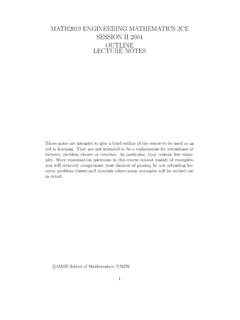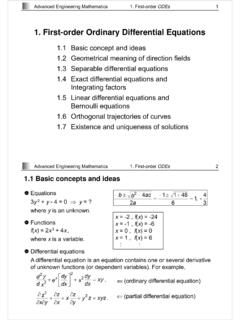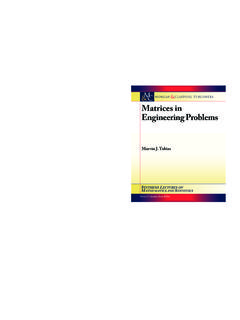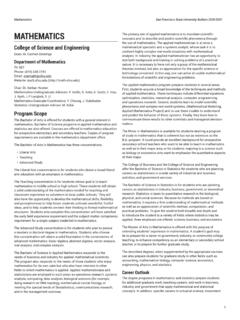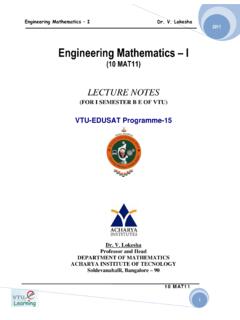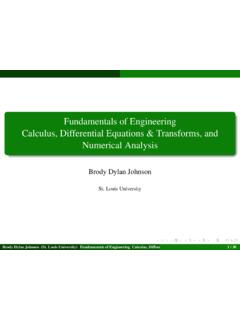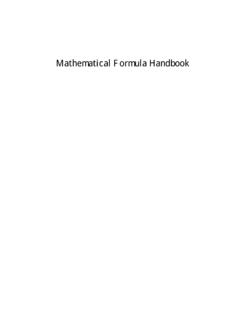Transcription of VECTOR CALCULUS - Sakshi Education
1 By Y. Prabhaker Reddy Asst. Professor of mathematics Guru Nanak engineering College Ibrahimpatnam, Hyderabad. mathematics -I VECTOR CALCULUS I YEAR SYLLABUS OF mathematics -I (AS PER JNTU HYD) Name of the Unit Name of the Topic Unit-I Sequences and Series Basic definition of sequences and series Convergence and divergence. Ratio test Comparison test Integral test Cauchy s root test Raabe s test Absolute and conditional convergence Unit-II Functions of single variable Rolle s theorem Lagrange s Mean value theorem Cauchy s Mean value theorem Generalized mean value theorems Functions of several variables Functional dependence, Jacobian Maxima and minima of function of two variables Unit-III Application of single variables Radius.
2 Centre and Circle of curvature Evolutes and Envelopes Curve Tracing-Cartesian Co-ordinates Curve Tracing-Polar Co-ordinates Curve Tracing-Parametric Curves Unit-IV Integration and its applications Riemann Sum Integral representation for lengths Integral representation for Areas Integral representation for Volumes Surface areas in Cartesian and Polar co-ordinates Multiple integrals-double and triple Change of order of integration Change of variable Unit-V Differential equations of first order and their applications Overview of differential equations Exact and non exact differential equations Linear differential equations Bernoulli Newton s Law of cooling Law of Natural growth and decay Orthogonal trajectories and applications Unit-VI Higher order Linear and their applications Linear of second and higher order with constant coefficients term of the form exp(ax) term of the form sin ax and cos ax term of the form exp(ax) v(x) term of the form exp(ax) v(x)
3 Method of variation of parameters Applications on bending of beams, Electrical circuits and simple harmonic motion Unit-VII Laplace Transformations LT of standard functions Inverse LT first shifting property Transformations of derivatives and integrals Unit step function, Second shifting theorem Convolution theorem-periodic function differentiation and integration of transforms Application of laplace transforms to ODE Unit-VIII VECTOR CALCULUS Gradient, Divergence, curl Laplacian and second order operators Line, surface , volume integrals Green s Theorem and applications Gauss Divergence Theorem and applications Stoke s Theorem and applications CONTENTS UNIT-8 VECTOR CALCULUS Gradient, Divergence, Curl Laplacian and Second order operators Line, surface and Volume integrals Green s Theorem and applications Gauss Divergence Theorem and application Stoke s Theorem and applications differentiation of Vectors Scalar: A Physical Quantity which has magnitude only is called as a Scalar.
4 Ex: Every Real number is a scalar. VECTOR : A Physical Quantity which has both magnitude and direction is called as VECTOR . Ex: Velocity, Acceleration. VECTOR Point Function: Let be a Domain of a function, then if for each variable Unique association of a VECTOR , then is called as a VECTOR Point Function. , where are called components of . Scalar Point Function: Let be a Domain of a function, then if for each variable Unique association of a Scalar , then is called as a Scalar Point Function. Note: 1) Two Vectors and are said to be Orthogonal (or ) to each other if 2) Two Vectors and are said to be Parallel to each other if . 3) If are three vectors, then a) b) c) 4) If are three VECTOR point functions over a scalar variable then a) + b).
5 C) d) e) Constant VECTOR Function: A VECTOR Point Function is said to be constant VECTOR function if are constant. Note: A VECTOR Point Function is a constant VECTOR function iff A VECTOR point function has constant magnitude if A VECTOR point function has constant direction if VECTOR Differential Operator The VECTOR Differential Operator is denoted by (read as del) and is defined as Now, we define the following quantities which involve the above operator. Gradient of a Scalar point function Divergence of a VECTOR point function Curl of a VECTOR point function Gradient of a Scalar point function If be any Scalar point function then, the Gradient of is denoted by (or) , defined as (Or) Gradient: Let is a scalar point function, then the gradient of is denoted by (or) and is defined as Ex: 1) If then 2) If then 3) If then Note: The Operator gradient is always applied on scalar field and the resultant will be a VECTOR .
6 The operator gradient converts a scalar field into a VECTOR field. Properties: If and are continuous and differentiable scalar point functions then Proof: To Prove Consider Similarly, we can prove other results also. Show that Let , then . If is any Scalar point function, then If where then (1) (2) (3) (4) (5) (6) Sol.
7 Given that and Differentiate partially, we get Similarly, (1) (2) Here means differentiation (3) (4) Similarly, we can prove this (5) Similarly, we can prove this (6) Note: If is any scalar point function (surface), then Normal VECTOR along is given by (or) and Unit Normal VECTOR along is Directional Derivative The directional derivative of a scalar point function at point in the direction of a VECTOR point function is given by , where is unit VECTOR along . Note: If is any scalar point function, then along the direction of , the directional derivative of is maximum, and also the maximum value of directional derivative of at point is given by.
8 Is parallel to -axis Co-efficient of and Co-efficient of is parallel to -axis Co-efficient of and Co-efficient of is parallel to -axis Co-efficient of and Co-efficient of Angle Between two surfaces If is the angle between the two surfaces and , then Angle between two vectors The angle between the two vectors is given by Note: If be position VECTOR along any VECTOR where are in terms of scalar , then gives velocity and gives acceleration. If is velocity of a particle, then the component of velocity in the direction of is given by If is acceleration of a particle then the component of acceleration in the direction of is given by Projection of a VECTOR The Projection of a VECTOR on is The Projection of a VECTOR on is Divergent: Let is a VECTOR point function, then the divergent of is denoted by (or) and is defined as Ex: 1) If then 2) If then If we substitute values, then we get VECTOR point function Note: 1) The Operator divergent is always applied on a VECTOR field, and the resultant will be a scalar.
9 The operator divergent will converts a VECTOR into a scalar. 2) Divergent of a constant VECTOR is always zero Ex: then . Solenoidal VECTOR : If , then is called as Solenoidal VECTOR . Ex: If is Solenoidal VECTOR . Curl of a VECTOR : Let is a VECTOR valued function, then curl of VECTOR is denoted by and is defined as Ex: 1) If then 2) If then Note: The Operator curl is applied on a VECTOR field. Irrotational VECTOR : The VECTOR is said to be Irrotational if . Ex: If then is called as Irrotational VECTOR . Note: 1) If is always an Irrotational VECTOR . 2) If is always Solenoidal VECTOR . Theorems 1) If is any scalar point function and is a VECTOR point function , then (Or) Sol: To Prove Consider 2) If is any scalar point function and is a VECTOR point function , then (or) Sol: To Prove Consider 3) If and are two VECTOR point functions then, Sol.
10 Let us consider In consider Similarly, Now, 4) Prove that Sol: Consider : We know that and Since is a VECTOR , take it inside summation.
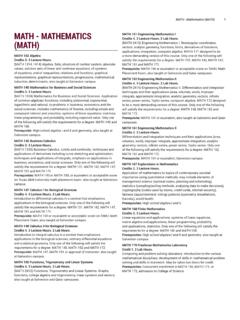
![[Engineering Mathematics]](/cache/preview/1/e/f/3/d/f/5/2/thumb-1ef3df52d76a8c1d51851076ed688d22.jpg)
